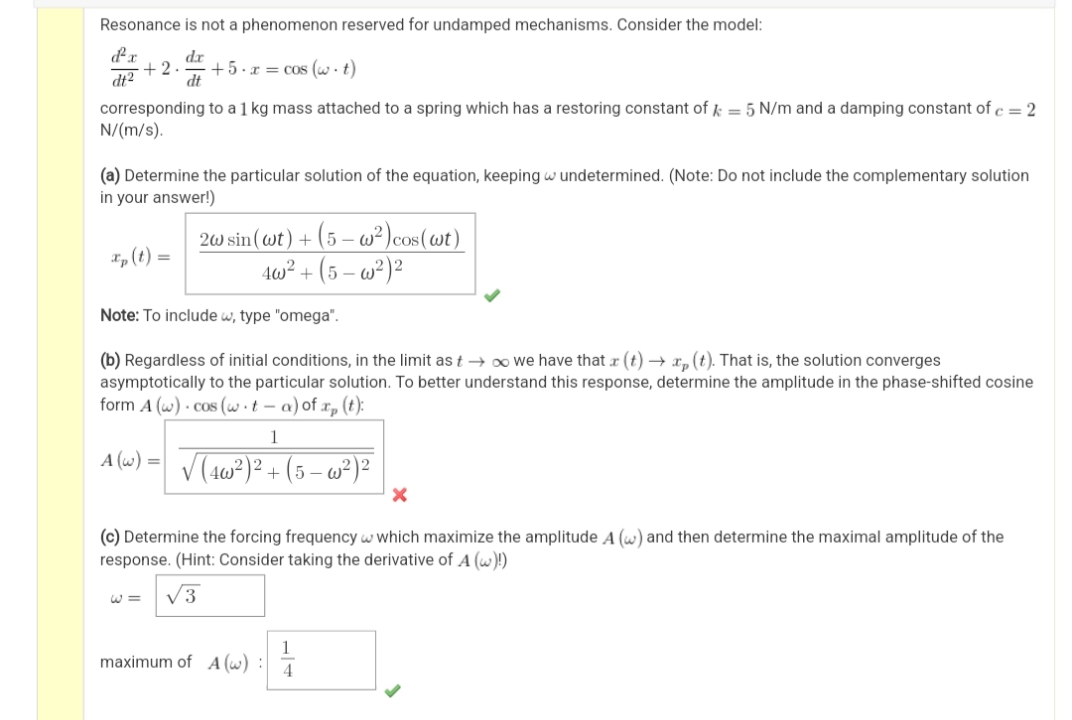Resonance is not a phenomenon reserved for undamped mechanisms. Consider the model: d²x dr +2. +5.x = cos (w-t) dt2 dt corresponding to a 1 kg mass attached to a spring which has a restoring constant of k = 5 N/m and a damping constant of c = 2 N/(m/s). (a) Determine the particular solution of the equation, keeping w undetermined. (Note: Do not include the complementary solution in your answer!) xp (t) = 2w sin (wt) + (5-w²) cos(wt) 4w²+(5-w²)² Note: To include w, type "omega". (b) Regardless of initial conditions, in the limit as t→∞ we have that x (t)→ xp (t). That is, the solution converges asymptotically to the particular solution. To better understand this response, determine the amplitude in the phase-shifted cosine form A (w) cos (w.t-a) of x₂ (t): 1 A (w) = √(46²)² + (5 − w²) ² X (c) Determine the forcing frequency w which maximize the amplitude A (w) and then determine the maximal amplitude of the response. (Hint: Consider taking the derivative of A (w)!) √3 maximum of A (w): 1 4
Resonance is not a phenomenon reserved for undamped mechanisms. Consider the model: d²x dr +2. +5.x = cos (w-t) dt2 dt corresponding to a 1 kg mass attached to a spring which has a restoring constant of k = 5 N/m and a damping constant of c = 2 N/(m/s). (a) Determine the particular solution of the equation, keeping w undetermined. (Note: Do not include the complementary solution in your answer!) xp (t) = 2w sin (wt) + (5-w²) cos(wt) 4w²+(5-w²)² Note: To include w, type "omega". (b) Regardless of initial conditions, in the limit as t→∞ we have that x (t)→ xp (t). That is, the solution converges asymptotically to the particular solution. To better understand this response, determine the amplitude in the phase-shifted cosine form A (w) cos (w.t-a) of x₂ (t): 1 A (w) = √(46²)² + (5 − w²) ² X (c) Determine the forcing frequency w which maximize the amplitude A (w) and then determine the maximal amplitude of the response. (Hint: Consider taking the derivative of A (w)!) √3 maximum of A (w): 1 4
Advanced Engineering Mathematics
10th Edition
ISBN:9780470458365
Author:Erwin Kreyszig
Publisher:Erwin Kreyszig
Chapter2: Second-order Linear Odes
Section: Chapter Questions
Problem 1RQ
Related questions
Question
100%
Solve b part only plz now

Transcribed Image Text:Resonance is not a phenomenon reserved for undamped mechanisms. Consider the model:
d²x
dr
+2. +5.x = cos (w.t)
dt²
dt
corresponding to a 1 kg mass attached to a spring which has a restoring constant of k = 5 N/m and a damping constant of c = 2
N/(m/s).
(a) Determine the particular solution of the equation, keeping w undetermined. (Note: Do not include the complementary solution
in your answer!)
xp (t) =
2w sin (wt) + (5-w²) cos(wt)
4w²+(5-w²)²
Note: To include w, type "omega".
(b) Regardless of initial conditions, in the limit as t→ ∞ we have that x (t)→ xp (t). That is, the solution converges
asymptotically to the particular solution. To better understand this response, determine the amplitude in the phase-shifted cosine
form A (w) cos (w.t-a) of x₂ (t):
1
A (w) = √(46²)² + (5 − w²)²
X
(c) Determine the forcing frequency w which maximize the amplitude A (w) and then determine the maximal amplitude of the
response. (Hint: Consider taking the derivative of A (w)!)
√3
maximum of A (w):
144
Expert Solution
This question has been solved!
Explore an expertly crafted, step-by-step solution for a thorough understanding of key concepts.
This is a popular solution!
Trending now
This is a popular solution!
Step by step
Solved in 3 steps with 3 images

Recommended textbooks for you

Advanced Engineering Mathematics
Advanced Math
ISBN:
9780470458365
Author:
Erwin Kreyszig
Publisher:
Wiley, John & Sons, Incorporated

Numerical Methods for Engineers
Advanced Math
ISBN:
9780073397924
Author:
Steven C. Chapra Dr., Raymond P. Canale
Publisher:
McGraw-Hill Education

Introductory Mathematics for Engineering Applicat…
Advanced Math
ISBN:
9781118141809
Author:
Nathan Klingbeil
Publisher:
WILEY

Advanced Engineering Mathematics
Advanced Math
ISBN:
9780470458365
Author:
Erwin Kreyszig
Publisher:
Wiley, John & Sons, Incorporated

Numerical Methods for Engineers
Advanced Math
ISBN:
9780073397924
Author:
Steven C. Chapra Dr., Raymond P. Canale
Publisher:
McGraw-Hill Education

Introductory Mathematics for Engineering Applicat…
Advanced Math
ISBN:
9781118141809
Author:
Nathan Klingbeil
Publisher:
WILEY

Mathematics For Machine Technology
Advanced Math
ISBN:
9781337798310
Author:
Peterson, John.
Publisher:
Cengage Learning,

